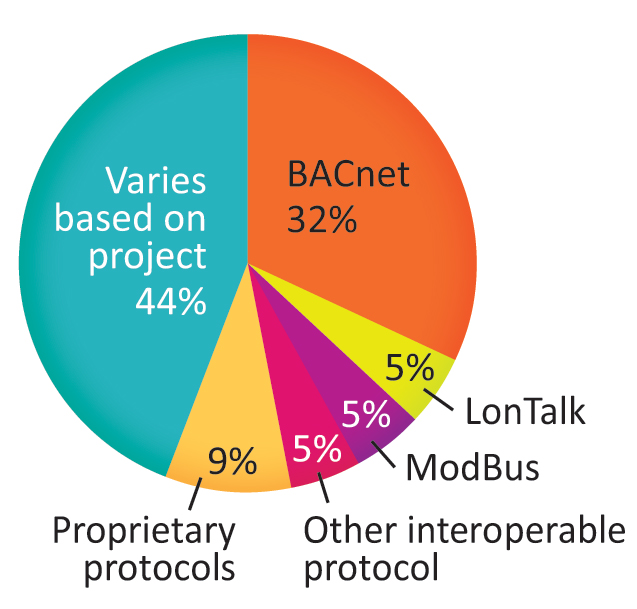The Facility Manager's Role in Planning BACnet
The role of the facility manager in planning for a BACnet system depends on whether the project is new construction or a retrofit, Haakenstad says.
"On new construction projects, the facility executive must make sure that he or she understands how the specification for BACnet networking is set for each piece of equipment to be connected to the control system," he says. "He or she also must decide how much integration between the control system and other systems should occur, if at all. On retrofit projects, the facility executive's considerations center around the existing equipment that must be controlled, whether new equipment will be installed, what points need to be monitored and how to control the system and equipment in the most efficient manner."
With this in mind, Mike Olson, manager — HVAC applications for ABB Inc., says one of the most important planning items when determining the right kind of BACnet system to design and install is to develop a scheme that makes sense for the facility, whether it is new construction or a retrofit.
"The facility executive needs to be very clear in the specification on what BACnet object (points) need to be monitored or controlled via the BACnet system," he says. "If capabilities are designed into the system upfront, you won't have to hire a design engineer to change lines of programming code after the fact to add desired capabilities."
Throughout the design and installation process, facility managers should ensure that everyone involved in the project stays focused on the needs of the facility. "Facility executives should avoid getting too technical too quickly," Cowles says. "Controls companies and consulting engineers can move quickly to focus on capabilities of hardware and software and associated checklists of features. Keep requirements in plain English and let all parties concerned know what's wanted in the end. When the desired end result is known, it's easy to ask the potential providers, 'Can you do this?' or 'Can you prove that you can do this?'"
Halvorson agrees. "Some people are afraid, confused or unsure of how to deal with issues in the IT areas," Halvorson says. "With so many acronyms in today's world, facility executives should be thinking in simple terms, based on the big picture issues of building costs to operate safety, environment, security and function of the building."
As Steve Tom, director of technical information at Automated Logic points out, different vendors have different design goals for their systems. Things that are easy to do with one system might be difficult, or even impossible, with another.
"Building automation systems are, surprisingly enough, designed as systems," Tom says. "They are not designed to be a collection of mix-and-match components supplied by the vendor of the week."
When systems are designed to be capable of handling interchangeable components, the least capable component drives the requirements of the system. "I have seen specifications that required entire systems to slow down the network just so the system could accept a slower component if it ever became necessary to install one," Tom says.
That's where BACnet comes in. BACnet makes it possible to use bridges, routers and other devices to integrate a variety of network types and speeds into a unified system.
"It is important to specify and vigorously require products to implement BACnet properly and per the intent of an open protocol," says Levi Tully, an application engineer at Reliable Controls. "This can be achieved very simply by requiring only native BACnet devices throughout the entire architecture of the internetwork, from the operator workstation and building controllers, all the way down to field-level devices. This prevents manufacturers and contractors from substituting proprietary and gateway devices that defeat many of the long-term sustainable benefits of an open protocol system."
However, even if a native BACnet system is specified, it's important to ensure that the network isn't overloaded now or in the future.
"Overloaded networks can negatively affect system performance," says Rick Fellows, vice president of business development for Delta Controls. "One common reason for network overloading is the use of higher-level devices, such as BACnet building controllers, performing functions that should be carried out by lower-level devices."
Without careful coordination during the design phase, it is likely there will be duplicate service IDs and network IDs within the BACnet system, says Jon Williamson, senior product manager for Schneider Electric.
"This can cause major communication failures," he says. "To mitigate this, it is important to work with a systems designer to assign IDs for each location, building, floor and device type and then assign specific IDs to vendors that have components in the system."
Working with consultants who are familiar with the BACnet standard can also prevent unclear specifications that could result in costly change orders, budget overruns and value-engineered solutions.
"Using the expertise of a master level integrator to handle the responsibility of the integrated system design, specification, review and implementation is one approach to ensure proper integration and interoperability," says Roy Kolasa, open systems market manager at Honeywell.
The bottom line: It's important that facility managers ensure that they bring in the right level of technical expertise. "One of the biggest mistakes is thinking that just because it is BACnet, it is all plug and play," says Rocky Moore, director of business development for American Auto-Matrix. "Facility professionals need to remember that these systems are complex. BACnet is designed for interoperation and to allow the freedom of choice. Yet you still need a qualified professional to do the job right."
Plans for New Controls Systems
If you are planning a new controls system, which of the following are you most likely to specify:

Source: BOM survey |
Related Topics:











